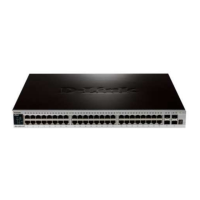xStack® DGS-3620 Series Managed Switch Web UI Reference Guide
233
BGP State
Use the drop-down menu to enable or disable the Border Gateway Protocol state. By
disabling the BGP protocol, all peers will be disconnected and dynamic routes will be
deleted. All the static configurations however will be reserved. If BGP is enabled
again, the previous configurations can be re-applied.
Synchronization
Usually, a BGP speaker does not advertise a route to an external neighbor unless
that route is local or exists in the IGP. By default, synchronization between BGP and
the IGP is turned off to allow the BGP to advertise a network route without waiting for
route validation from the IGP. This feature allows routers and access servers within
an Autonomous System to have the route before BGP makes it available to other
autonomous systems.
Enforce First AS
This command is used to enforce the neighbor’s AS as the first AS in the AS list.
When the setting is Enabled, any updates received from an external neighbor that do
not have the neighbor’s configured Autonomous System (AS) at the beginning of the
AS_PATH in the received update, will be denied and the neighbor will be closed.
Enabling this feature adds to the security of the BGP network by not allowing traffic
from unauthorized systems.
Always compare MED
Enable or disable the comparison of the Multi Exit Discriminator (MED) for paths from
the neighbors in different Autonomous Systems. By default this setting is Disabled.
Deterministic MED
Enable or disable to enforce the deterministic comparison of the Multi Exit
Discriminator (MED) for paths received from the neighbors within the same
Autonomous System. By default this setting is Disabled.
Best Path Option Choose from AS Path Ignore, Compare Router ID, Med Confed, MED Missing As
Worst, and Compare Confed Aspath.
AS Path Ignore – If selected, the BGP process will ignore the AS path in the path
selection process.
Compare Router ID – If selected, the BGP process will include the router ID in the
path selection process. Similar routes are compared and the route with the lowest
router ID is selected.
Med Confed – If selected, the BGP process will compare the MED for the routes that
are received from confederation peers. For routes that have an external AS in the
path, the comparison does not occur.
MED Missing As Worst – If selecteded, the BGP process will assign a value of infinity
to routes that are missing the Multi Exit Discriminator (MED) attribute. If disabled, the
BGP process will assign a value of zero to routes that are missing the Multi Exit
Discriminator (MED) attribute, causing this route to be chosen as the best path.
Compare Confed Aspath - If selected, the BGP process will compare the
confederation AS path length of the routes received. The shorter the confederation
AS path length, the better the route is.
Best Path Option State
Used the drop-down menu to enable or disable AS Path Ignore, Compare Router ID,
Med Confed, MED Missing As Worst, and Compare Confed Aspath. The default is
Disabled.
Default Local
Preference
(0-4294967295)
Enter a default local preference between 0 and 4294967295. The default value is
100.
Router Identifier
This field is used to set BGP router ID. An ID to identify a BGP router. If it is set to
zero the router ID will be automatically determined. User must specify a unique router
ID within the network.
Hold Time (0-65535)
The valid values are from 0 to 65535. The system will declare a peer as dead if a
keepalive message is received that is more than the hold time. The default value is
180 seconds. If the holdtime is set to zero, then the holdtime will never expire. If the
two routers that build a BGP connection have a different hold time, then the smaller
hold time will be used. If the timer is specified for specific neighbors, then the
neighbor specific timer will take effect. The hold time needs to be at least three times
that of the keepalive timer.

